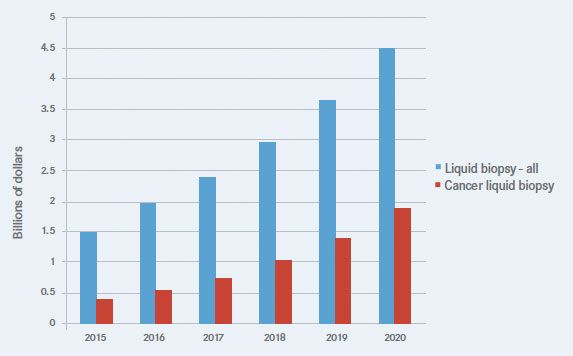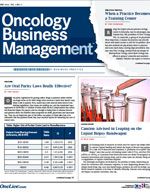Publication
Article
Oncology Business News®
Caution Advised in Leaping on the Liquid Biopsy Bandwagon
Author(s):
A profusion of so-called “liquid biopsy†tests that extract circulating tumor cells, cell-free DNA, or exosomes from blood and urine are under investigation at research institutions and startup firms, and in some cases are already being used to supplement or replace traditional biopsies.
Charles Ryan, MD
The booming field of research on blood tests for cancer has drawn billions in venture capital funding and raised the hopes of doctors and patients for a new era of detection and treatment. A profusion of so-called “liquid biopsy” tests that extract circulating tumor cells (CTCs), cell-free DNA (cfDNA or ctDNA), or exosomes from blood and urine are under investigation at research institutions and startup firms, and in some cases are already being used to supplement or replace traditional biopsies.
But although oncologists are wowed by the promise of easily monitoring patients for recurrence and treatment response, or even diagnosing disease via a simple blood draw, they note that liquid biopsy products are still not widely used. Much research remains to be done to identify clinically relevant tests and gauge the impact on patient outcomes, they say.
Experts also warn against overselling the promise of unproven technologies to patients and the general public. The FDA is watching liquid biopsy development and the genetic testing industry closely. In September the agency warned Pathway Genomics about its CancerIntercept Detect blood test for cancer biomarkers, which lacks FDA approval but is marketed directly to consumers. The company ships blood collection tubes—considered a “medical device” and subject to FDA regulations—for use in the test, and the test’s effectiveness has not been demonstrated, the agency said. “We believe you are offering a high risk test that has not received adequate clinical validation and may harm the public health,” the FDA wrote in a letter to Pathway.
The company responded that physicians are involved in ordering and reviewing the test, and said CancerIntercept Detect is a laboratory developed test or LDT, which is regulated by The Centers for Medicare & Medicaid Services rather than the FDA.
“The technology is important and impressive, but it’s the application of that technology that has become more difficult,” said J. Leonard Lichtenfeld, MD, deputy chief medical officer for the American Cancer Society, of liquid biopsies generally. “We have to be so careful about how we represent this technology and these opportunities to our patients. There’s one researcher who said in a corporate publication that this was going to help cure breast cancer. Well, it may help cure breast cancer. But that is in the distance. That is not today.”
The FDA recently proposed extending the regulations on medical device manufacturers to many LDTs, stoking industry concerns that the rules would be burdensome and stifle innovation. Lichtenfeld said he expects more clarity on LDT regulation sometime this year.
Meanwhile, research and development continues and the demand for liquid biopsies is expanding rapidly. The global market totaled $1.5 billion last year and cancer testing represented the fastest growing subsector, reaching $415 million in 2015 and projected to increase to $1.9 billion in 2020, according to a report by BCC Research.
Janssen, whose 12-year-old Cellsearch system is the only FDA-approved CTC test, says it is used in more than 25 NCI-designated cancer centers. Guardant Health, a leading cell-free DNA testing company, said 2000 US oncologists and 20,000 patients use its services annually. Insight Pharma Reports has identified 33 companies that are developing liquid biopsy products, eight of which have particularly promising products.
Despite all that activity, CTC and cfDNA tests still do not fit into the routine practice of oncology, Lichtenfeld said. In response to a query, the Community Oncology Alliance was able to identify only one member practice, Genesis Cancer Center in Hot Springs, Arkansas, that uses them regularly. Several years ago the four-physician practice took the highly unusual step of purchasing its own Cellsearch system, said Genesis oncologist Stephen Divers, MD. He recalled that his Medicare carrier was initially confused, having never been asked to cover the costs of such a machine.
Genesis conducted thousands of tests over two years, including several as part of a University of Arkansas trial on colon cancer recurrence, but Divers found that many patients had too few CTCs to make the system useful and he stopped using it. Two years ago the practice tried out a different kind of liquid biopsy, joining a pilot trial of Guardant cfDNA testing. It has since become a regular part of the practice’s toolkit.
Divers said he recently used the Guardant test for a lung cancer survivor with recurrence in her lymph nodes who stopped responding to erlotinib (Tarceva). He suspected a T790 mutation, but he was not sure if he could successfully biopsy her tumor, which was situated between the aorta and pulmonary artery.
She had also previously undergone lung surgery. Instead of performing another biopsy, he reviewed her CT scan, drew blood, confirmed the mutation, and switched her to osimertinib (Tagrisso), a newer oral EGFR inhibitor.
“The idea is that you tailor the therapy to the patient in the least invasive way possible, and adjust it according to the presence or absence of new mutational burden,” Divers said. “Or at least explain to the patient, ‘This is why your disease progressed.’ It makes the doctor look a lot smarter, and hopefully improves outcomes for the patient.”
Figure 1: Projected Growth of Liquid Biopsy Market
Figure 1: Projected Growth of Liquid Biopsy Market

Source: Based on projected sales data from BCC Research
In cases where tissue from a conventional biopsy is used up diagnosing the patient, cfDNA testing also lets Divers identify a specific mutation without performing a second biopsy. And Divers is looking forward to the day when blood tests may possibly not only confirm mutations but reliably monitor for relapse, allowing his patients to avoid unnecessary adjuvant therapies.
Oncologists dream of a variety of “holy grail” innovations from liquid biopsy research, some of which are nearly within sight. Charles Ryan, MD, of the University of California San Francisco, said researchers recently found they could use CTCs to detect the AR-V7 androgen receptor splice variant, which indicates resistance to enzalutamide and abiraterone in prostate cancer patients.
“That test has not become commercially available yet, so it’s a little frustrating,” said Ryan, who serves as prostate cancer expert for the American Society of Clinical Oncology. “But that is the holy grail. It’s very similar to a bacterial infection where you find out this bacteria is resistant to penicillin. Well, then you don’t use penicillin. And it’s sensitive to this other antibiotic, so you choose that. I think those days will come.”
Patrick Brown, MD, of Johns Hopkins Kimmel Cancer Center, noted that blood-based genetic tests are commonly used to supplement certain bone marrow biopsies, as in the detection of BCR-ABL mutations that indicate drug resistance in chronic myeloid leukemia.
Brown, a spokesman for the American Society of Hematology, said he’s excited about the prospect of next-generation genomic sequencing of such great sensitivity that it can reliably show that patients with certain childhood leukemias have no residual cancer cells after treatment and are definitively cured. However, such tests would still involve extracting bone marrow biopsy rather than a simple blood draw. Biotech firms are working on developing liquid biopsy versions; the firm Biofluidica recently reported progress on one for acute myeloid leukemia. But Brown said the propensity of AML cells to leak into the blood varies among patients, making it unlikely that one test could work for everyone.
“There’s some promise and a great idea in using the blood as a way to follow leukemia, but the part that complicates that is that not every leukemia is alike,” he said. “Maybe in the future there will be a way genetically or otherwise to be able to classify patients’ leukemias as being ones where blood testing would be adequate for following them, or where blood testing would be inadequate.”
The development of clinically useful liquid biopsies faces a number of hurdles. In addition to requiring sufficient presence of cancer particles in the blood, another one that Brown and other physicians cited is the lack of drugs to treat all the gene variants identified through next-generation sequencing of CTCs and cell-free DNA.
“The challenge is, what do we do with all the information?” Brown said. “For all the things that we find, the subset for which there’s actually a drug available that could potentially address that mutation—that’s a very small subset. Growing every day, but still a very small subset.”
Many patients are familiar with genetic testing and want their doctors to use it, even when therapies to address test findings do not exist, Ryan said. “I work in a pretty sophisticated area where we have a lot of people who themselves or whose family members work in biotech or technology,” he said. “So there’s kind of a push from people sometimes to get these tumor-sequencing results done and frequently to not much utility.”
Pathway Genomics offered its cancer test to the public despite not having done trials to demonstrate its value in early detection, drawing a warning from the FDA. Lichtenfeld said such tests must be approached with extreme caution. Physicians aren’t equipped to analyze the results, and even if an abnormality is detected it could very well be an indolent cancer, he said.
The growing availability of liquid biopsies has spurred speculation that blood tests could someday provide very early diagnosis and treatment of cancer and other diseases in apparently healthy people, a prospect that has been compared to the medicine on “Star Trek.” Lichtenfeld and the other oncologists were skeptical.
Divers called the idea of “curing cancer” a fallacy, given the fundamental, continuous nature of mutation and inflammation in living cells. Brown questioned how providers could determine the point at which the accumulation of a long series of mutations required treatment, and the difficulty of weighing the risks and societal costs of early interventions against the benefits. Lichtenfeld said it has not even been demonstrated that liquid biopsies improve outcomes in patients with different types of metastatic disease, much less in undiagnosed individuals.
“This question about early detection… How many thousands of people would have to be followed for how long to understand whether or not it makes a difference in the outcome for their cancer?” he said. “We’re not anywhere near doing that type of research at this point in time.”









